In our Summer 2021 issue we showcased highlights from Matt Oswalt’s collection of photographs of men and women posed with miniature flags and secession cockades. Here, we shine a light on representative images of his Confederate soldiers with connections to Mississippi.
Oswalt, a native of Itawamba County, Miss., traces his ancestry to soldiers on both sides of the conflict. When he began collecting images about a decade ago, Mississippi military men became his key focus. Since then, he has built a collection of soldier portraits that reveal the state’s varied uniforms, and stories that capture the unique experiences of Mississippi soldiers in the Eastern and Western Theaters.
Mississippi fielded some 116 units of artillery, cavalry, infantry and sharpshooters totaling about 80,000 men and officers to the Confederacy. Here is a representative sample of their portraits and stories.
Portraits of pards
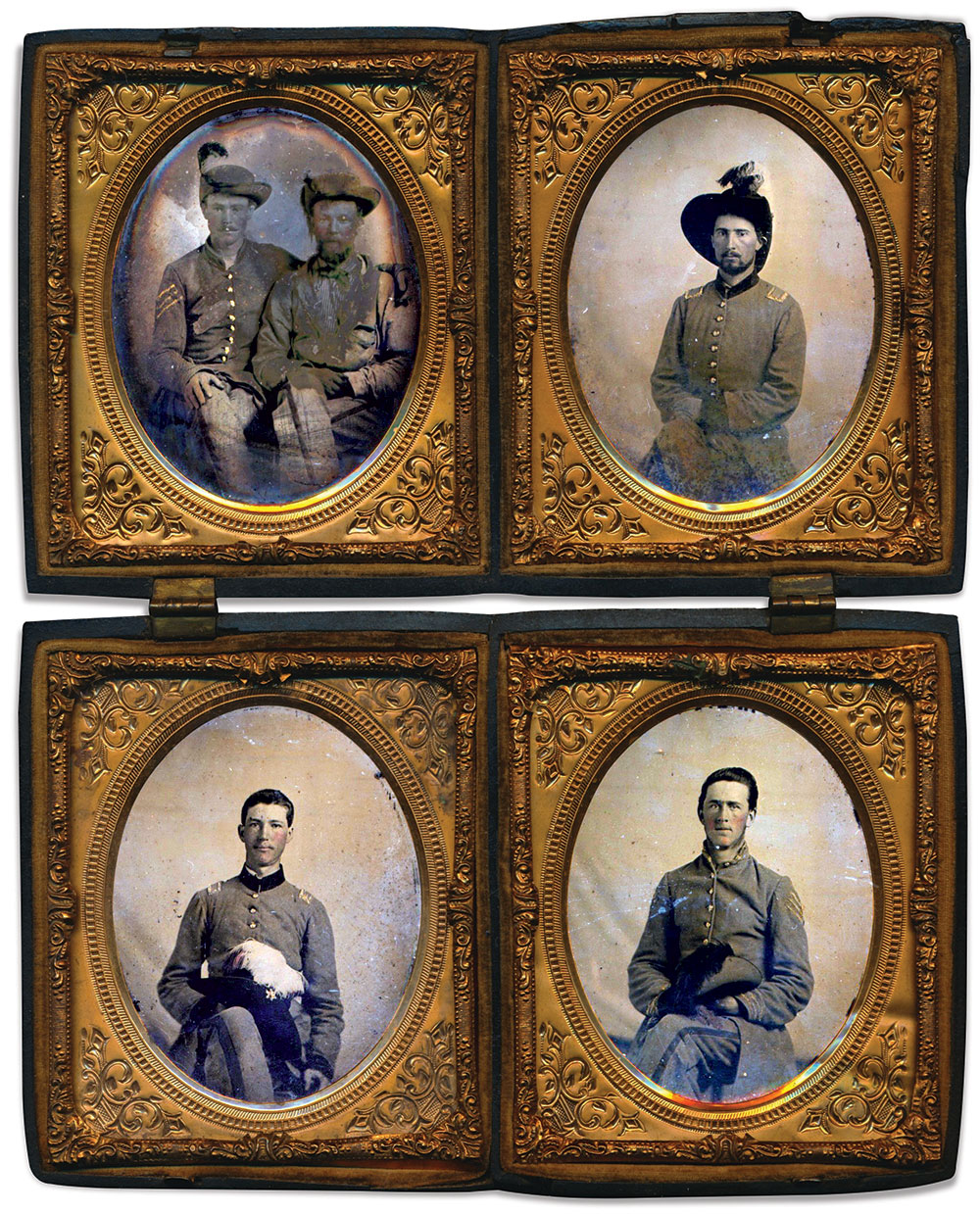
Though the men pictured in these images are unidentified, a comparison of their uniforms to portraits of known Mississippi soldiers suggests a likely connection to the Magnolia State.
Tricorn trooper
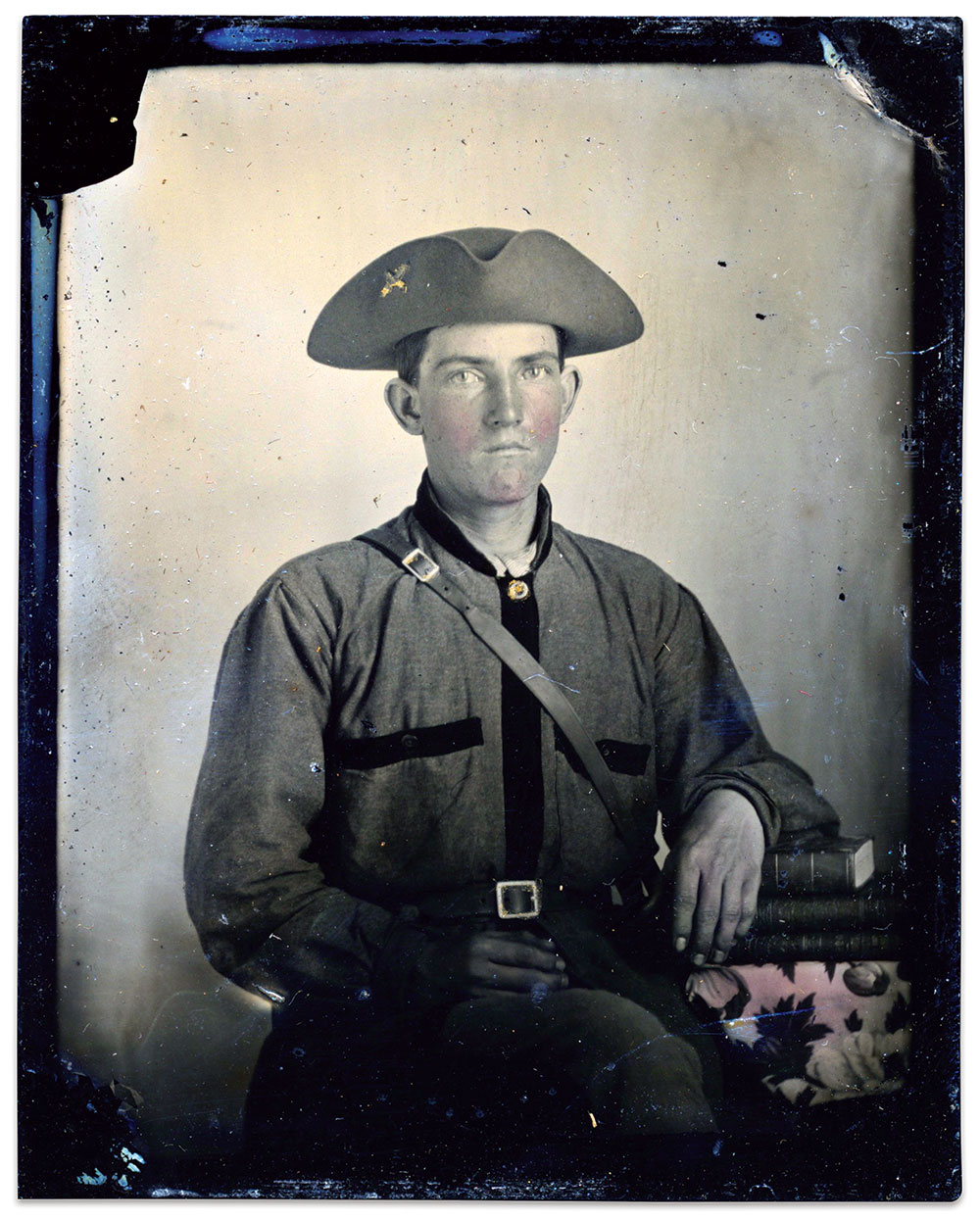
A cavalry trooper wears an overshirt, often referred to today as a battle shirt, with black trim on the collar, pockets, and center stripe. A single gilded button is visible at the collar opening. A leather shoulder strap with a small frame buckle may be attached to a haversack. His tricorn features a gilded crossed saber device. This uniform connects him to the 7th Mississippi Cavalry, also known as the 1st Mississippi Partisan Rangers. The regiment was primarily raised in Tippah and Pontotoc counties in North Mississippi.
Life-changing relocation
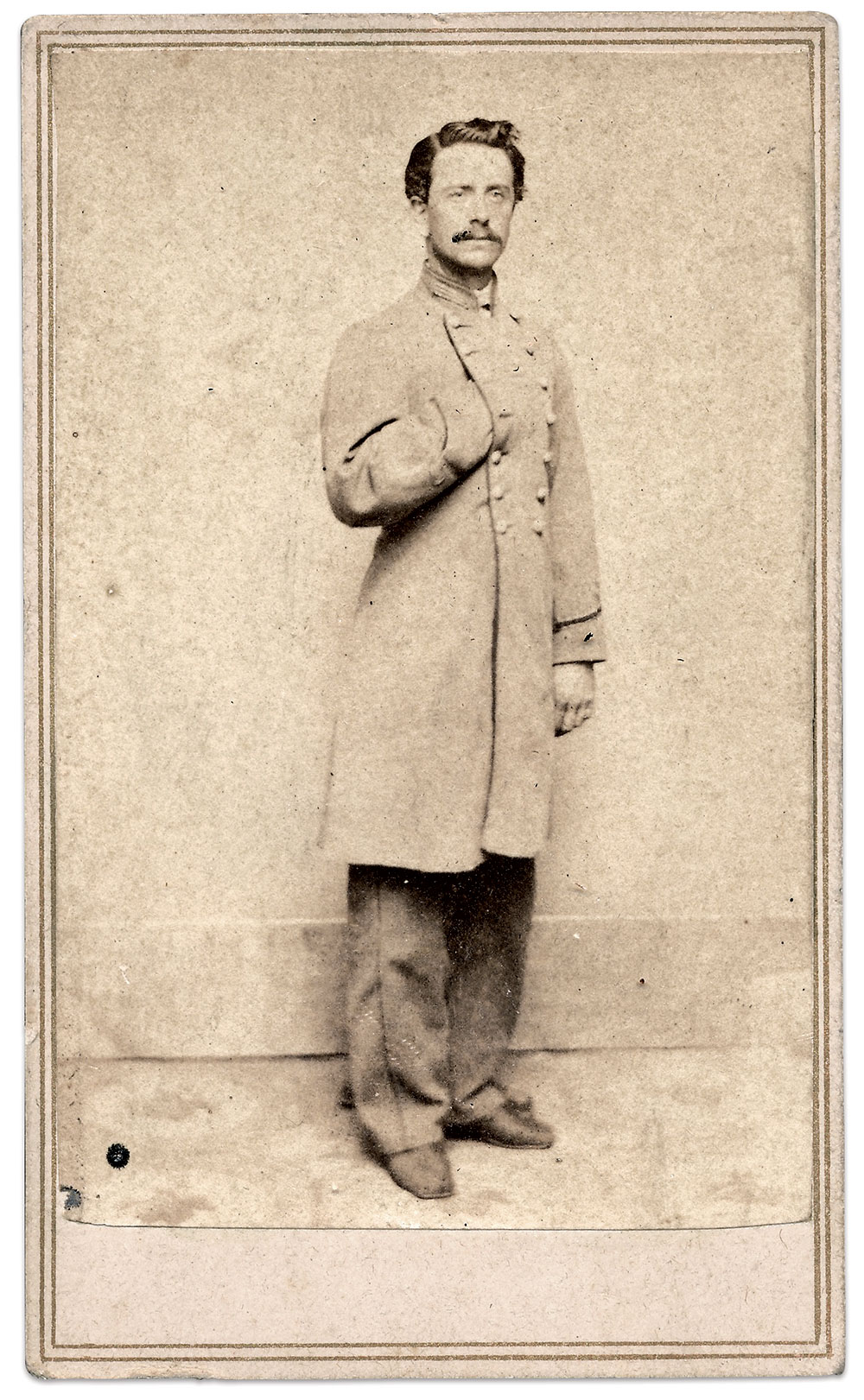
After graduating from New York’s Hamilton College in 1858, Empire State native Foster Ely followed a classmate to Mississippi. He decided to stay and became a preacher in Canton. Among those he befriended in his adopted home was Jefferson Davis.
When the war came, Ely cast his lot with the Confederate army. He joined the ranks of the 18th Mississippi Infantry and went on to fight in Virginia. In late 1861, he advanced to chaplain of his regiment. While serving in this capacity during the 1862 Peninsula Campaign, he suffered a wound at the Battle of Malvern Hill. Following his recovery, he became an ordained Methodist minister and spent the rest of the war tending to soldiers in Richmond, Atlanta, and Montgomery and Mobile in Alabama.
After the war, his spent the next half-century in churches primarily in the North and in Europe. He was also active as a coin and autograph collector. Ely died in 1916 at age 79, outliving two wives.
The Weatheralls
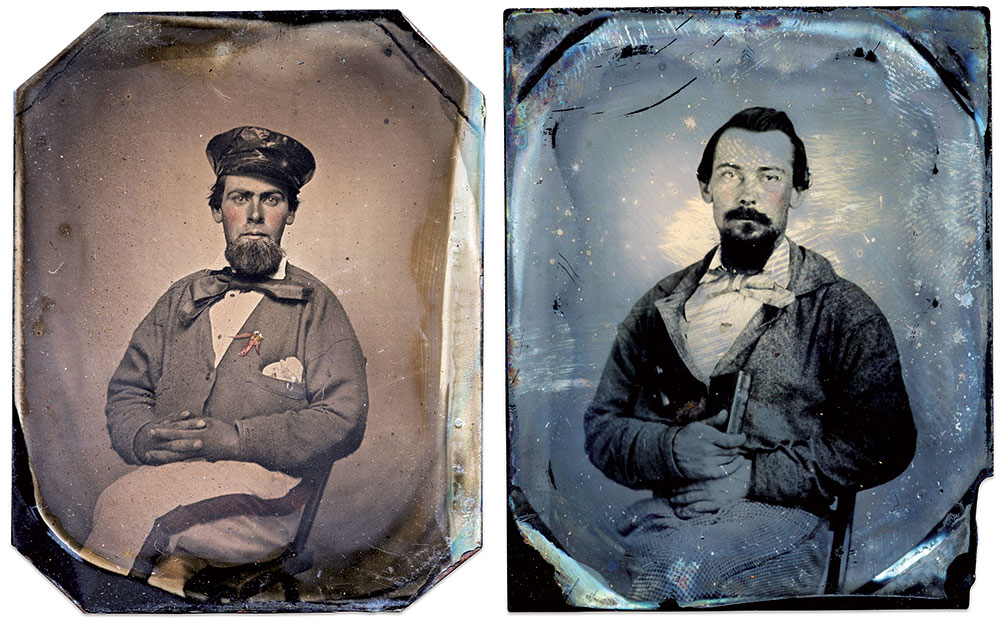
This portrait of a soldier wearing a generous cravat, thick-striped trousers, cap with rain cover, and what appears to be a cockade on his lapel is inscribed on the back “May the 6th 1861, Harrisburg M, Sam’l W. Weatherall.”
Three days later, Samuel Watt Weatherall (1835-1899) received a second lieutenant’s commission in Capt. William D. Bradford’s Mississippi Artillery Company (Confederate Guards Artillery) in Pontotoc, Miss. The unit subsequently became known as Capt. John O. Grisham’s Mississippi Confederate Guards Artillery and served mainly in North Carolina under Lt. Gen. Daniel H. Hill.
About May 1864, Weatherall joined Company C of the 2nd Battalion Mississippi State Cavalry (Harris’) as a first lieutenant. Formed in Tupelo, the troopers consolidated with the 3rd Battalion to form the 11th Regiment Mississippi Cavalry (Ashcroft’s).
Union cavalry raiders captured Weatherall in Mississippi at the Battle of Egypt Station on Dec. 28, 1864. Forwarded to Johnson’s Island, Ohio, he spent the rest of the war as prisoner, and took the Oath of Allegiance to the federal government on June 17, 1865. He relocated to Florida at some point after his release. He is buried in Oaklawn Cemetery in Plant City.
Weatherall’s cousin, Lafayette (1827-1892) of Pontotoc, Miss., likely posed for this portrait in May 1861, about the time of his enlistment as a sergeant in Capt. William D. Bradford’s Mississippi Artillery Company (Confederate Guards Artillery). Cousin Samuel served in the same company.
Lafayette sits with a book in hand and a revolver at his side. His jacket is open to reveal a shield insignia attached to his shirt. His trousers are checked with a stripe down the side.
Regulation uniform, militia staff officer’s sword
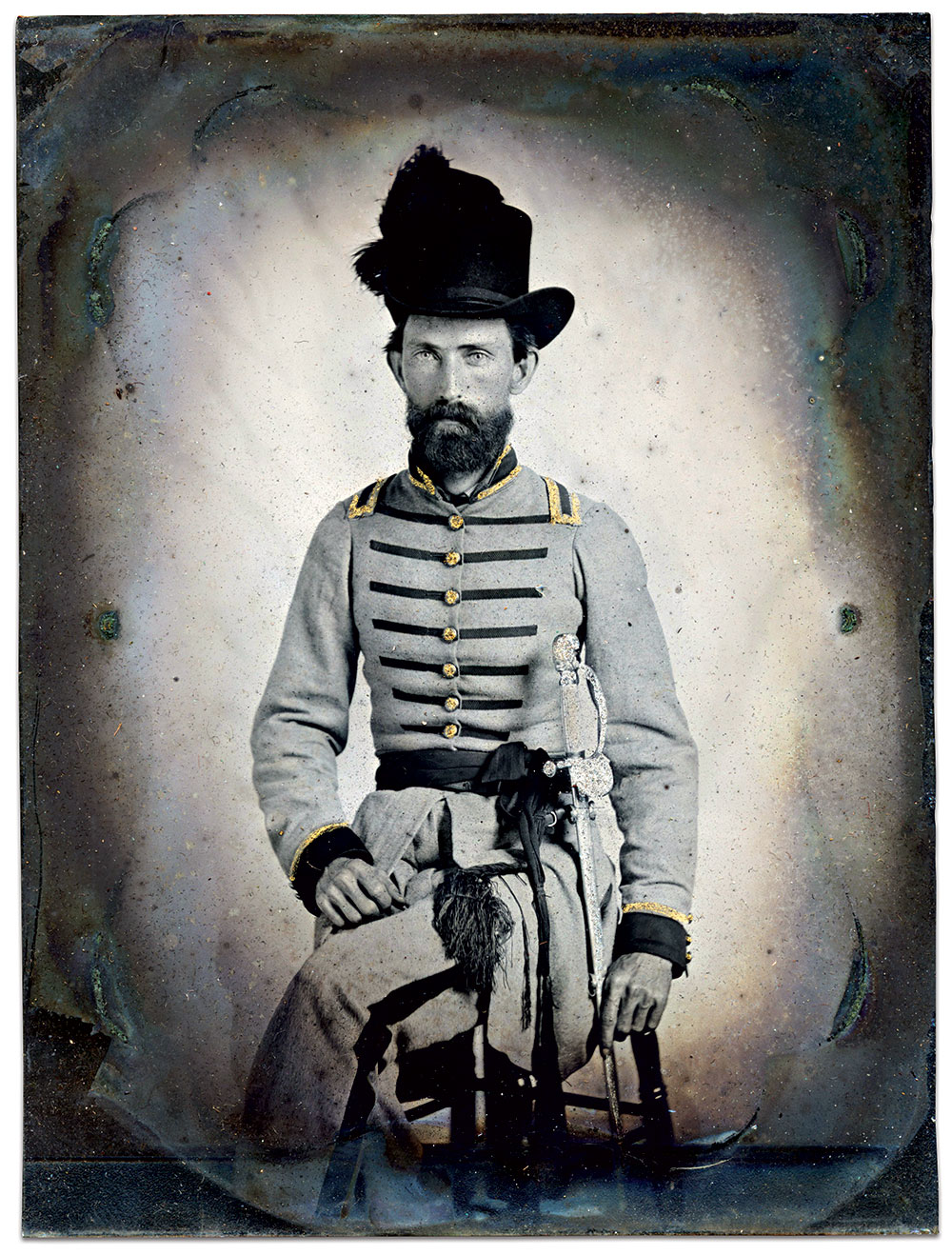
The uniform worn by this soldier appears to follow regulations issued by the Mississippi State Military Board in 1861. He wears a gray frock coat that extends to the thigh, with dark collar, cuffs and shoulder straps bordered by gold lace. The cuffs are fastened with three buttons. The coat buttons have been gilded, obscuring the details. Pleated braid extending horizontally from the buttons appears to be the same material as his cuff and collar. Matching trousers feature a dark side stripe. He also wears a plumed Hardee-style hat of a dark material pinned on one side.
At his side is a militia staff officer’s sword with knight’s helmet pommel, and a grip likely made of bone with a clam shell counter guard and brass knuckle-bow. MI Contributing Editor Ron Maness notes, “The belt is either a single or double billet configuration commonly worn within the Confederate ranks. He has organized (it appears) another leather strap with a roller buckle to pass through at least one of the upper scabbard rings, though it may pass through both upper rings. This strap apparently loops around his waist belt to support the sword. This is simple improvisation.”
Member of the Lafayette Farmers
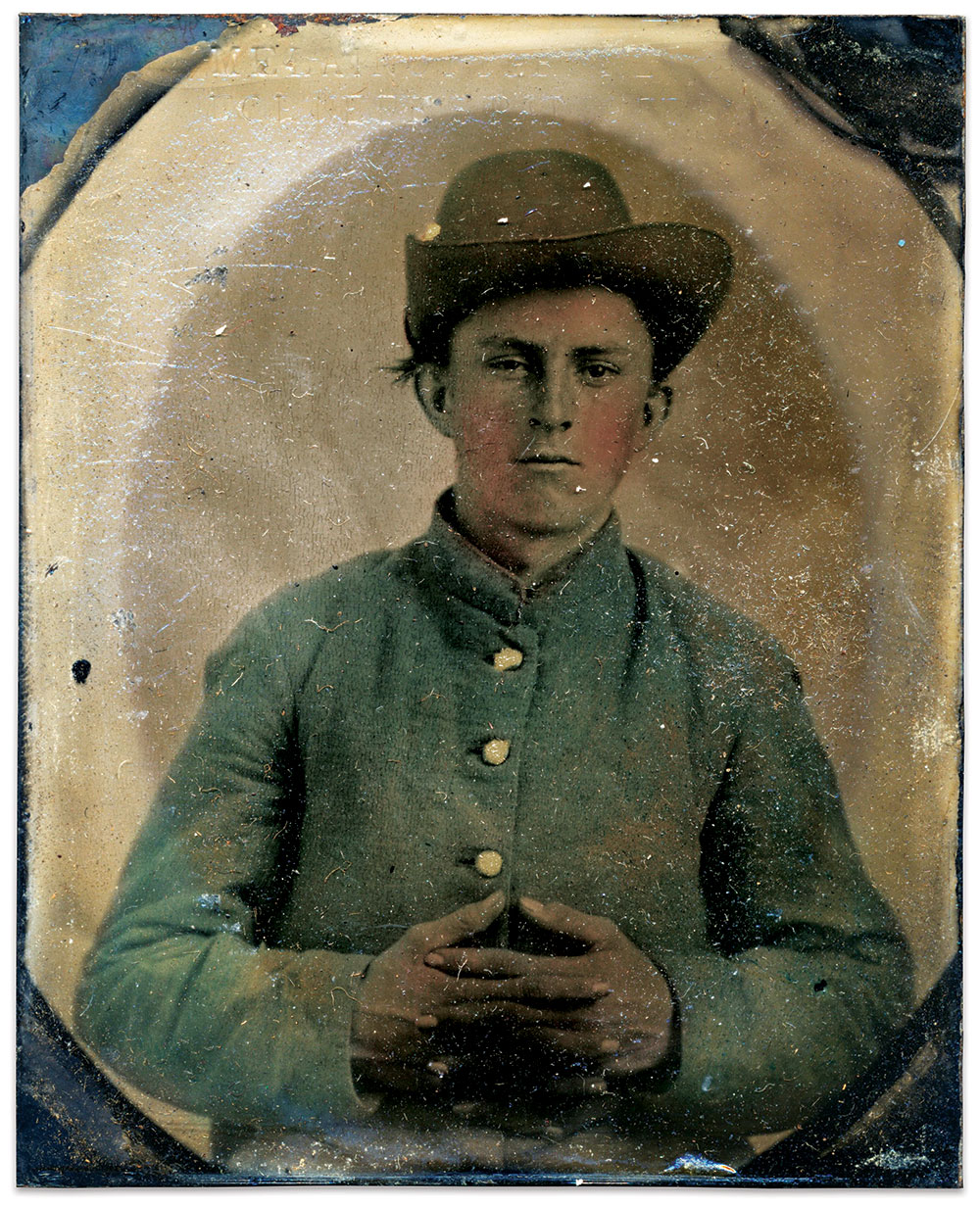
The Lafayette Farmers formed for military service at Oxford, Miss., in July 1861. Its membership included the soldier pictured here, 17-year-old Richard Francis Marion Houston. He and his comrades mustered into the Confederate army as Company H of the 22nd Mississippi Infantry, and participated in the Battle of Shiloh, operations around Baton Rouge and Corinth, Miss., and the Vicksburg Campaign. Houston proved a capable soldier, rising in rank from private to first lieutenant. On May 30, 1863, while on special duty for Gen. Joseph E. Johnston at Vicksburg, Houston fell into enemy hands. He spent much of the rest of the war at prisoner of war camps at Alton, Ill., and Johnson’s Island, Ohio. Union authorities transferred him to Point Lookout, Md., on Feb. 20, 1865. His record ends at this point. This image reportedly came out of the estate of historian and author Shelby Foote.
A Sunflower Disperser
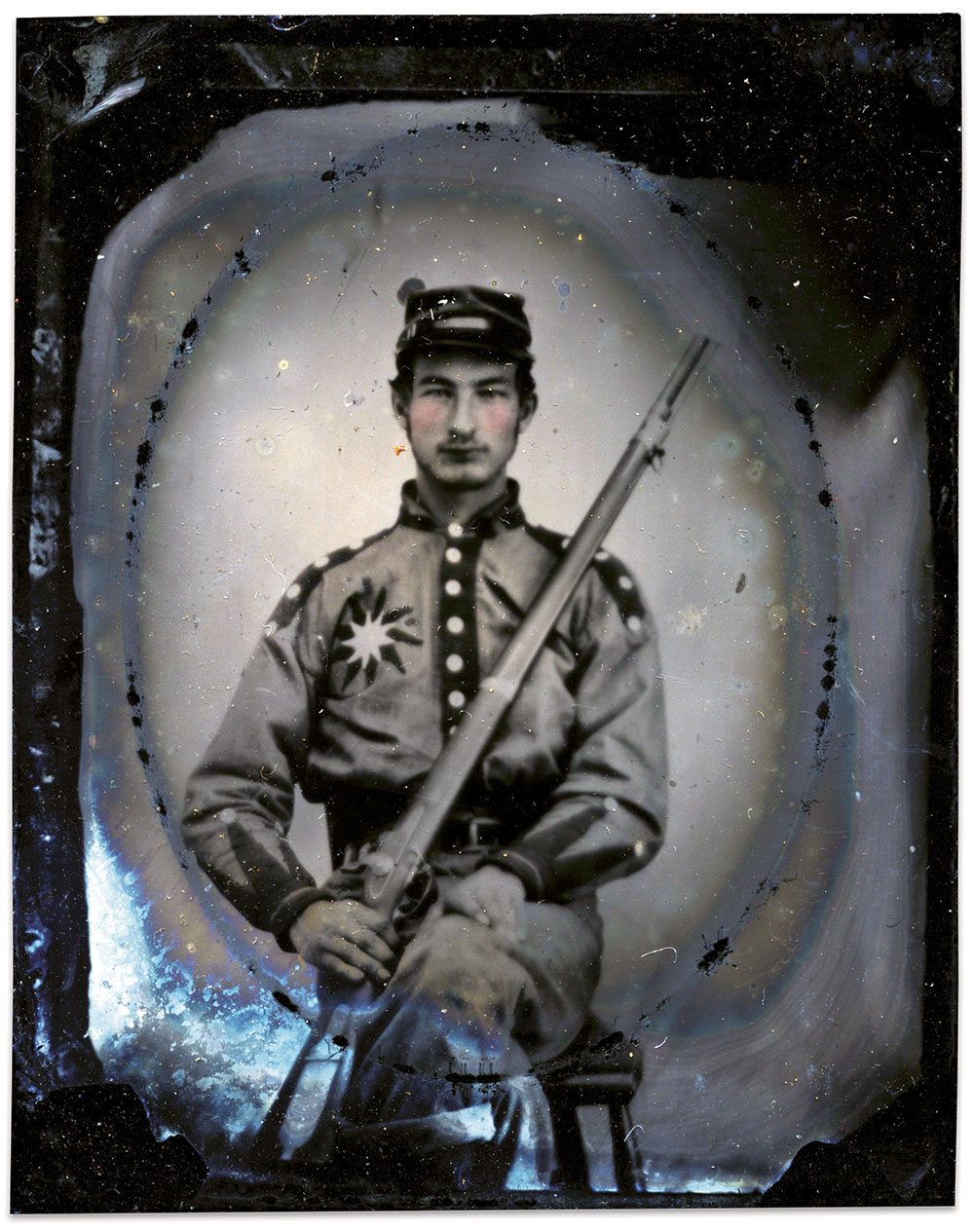
The Sunflower Dispersers formed in Sunflower County, Miss., and became Company B of the 3rd Mississippi Infantry. The regiment participated in numerous actions, including the Vicksburg and Atlanta Campaigns and the Tennessee battles of Franklin and Nashville.
This unidentified soldier wears the Dispersers’ distinctive gray jacket trimmed in red with a large red and yellow sunflower over his heart. His matching gray cap features red piping and a red band around the base. His gray trousers are held up with a leather waist belt. He holds a Model 1841 Mississippi Rifle.
Southern star
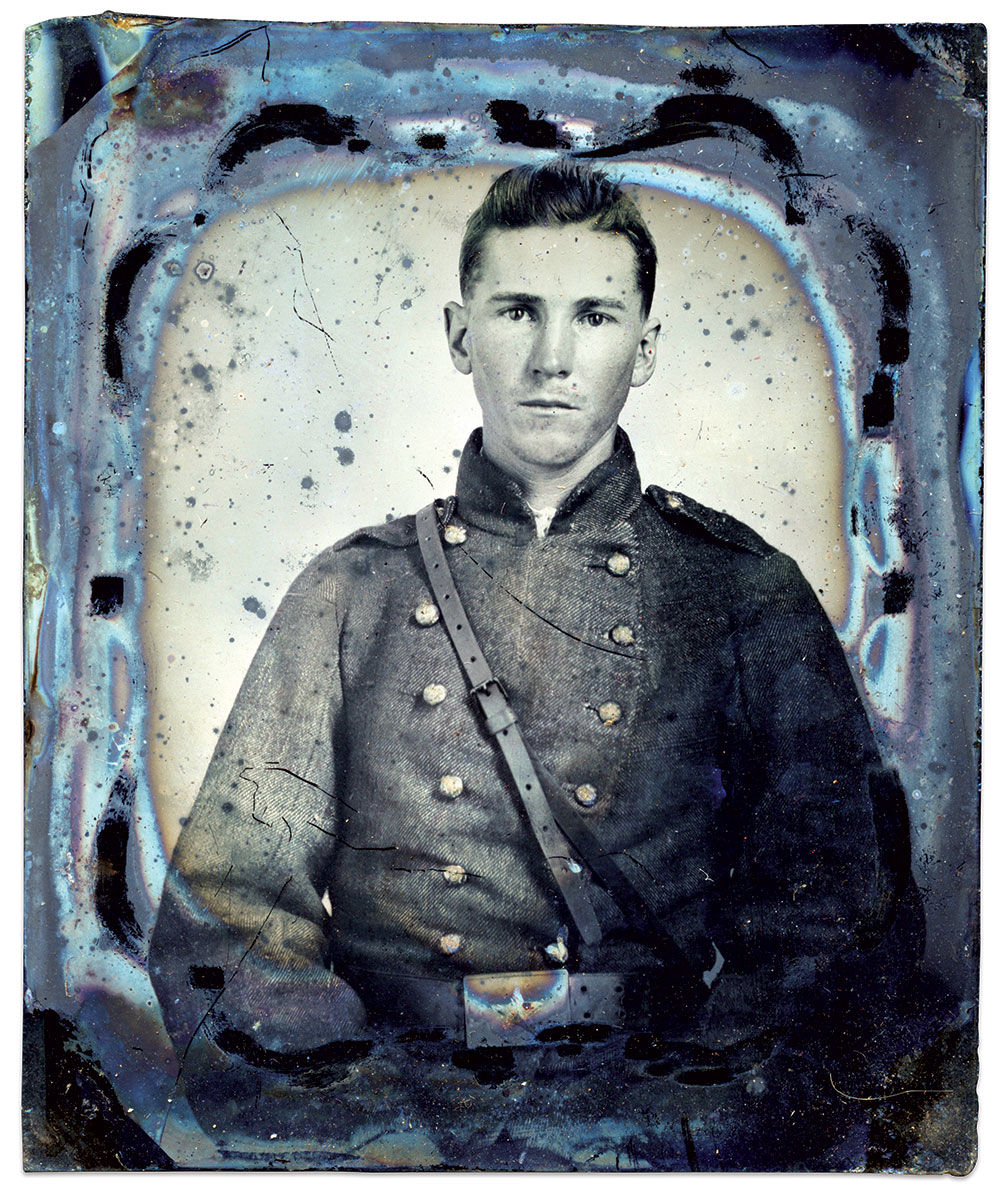
The Mississippi state star is emblazoned on the waist belt buckle of this Southern soldier. He wears a coarsely woven double-breasted jacket with epaulettes and gilded buttons, which appear of the Mississippi militia star variety. The collar has a dark border on the upper aspect. A leather strap disappears beneath his uniform sleeve.
A Lamar Rifleman
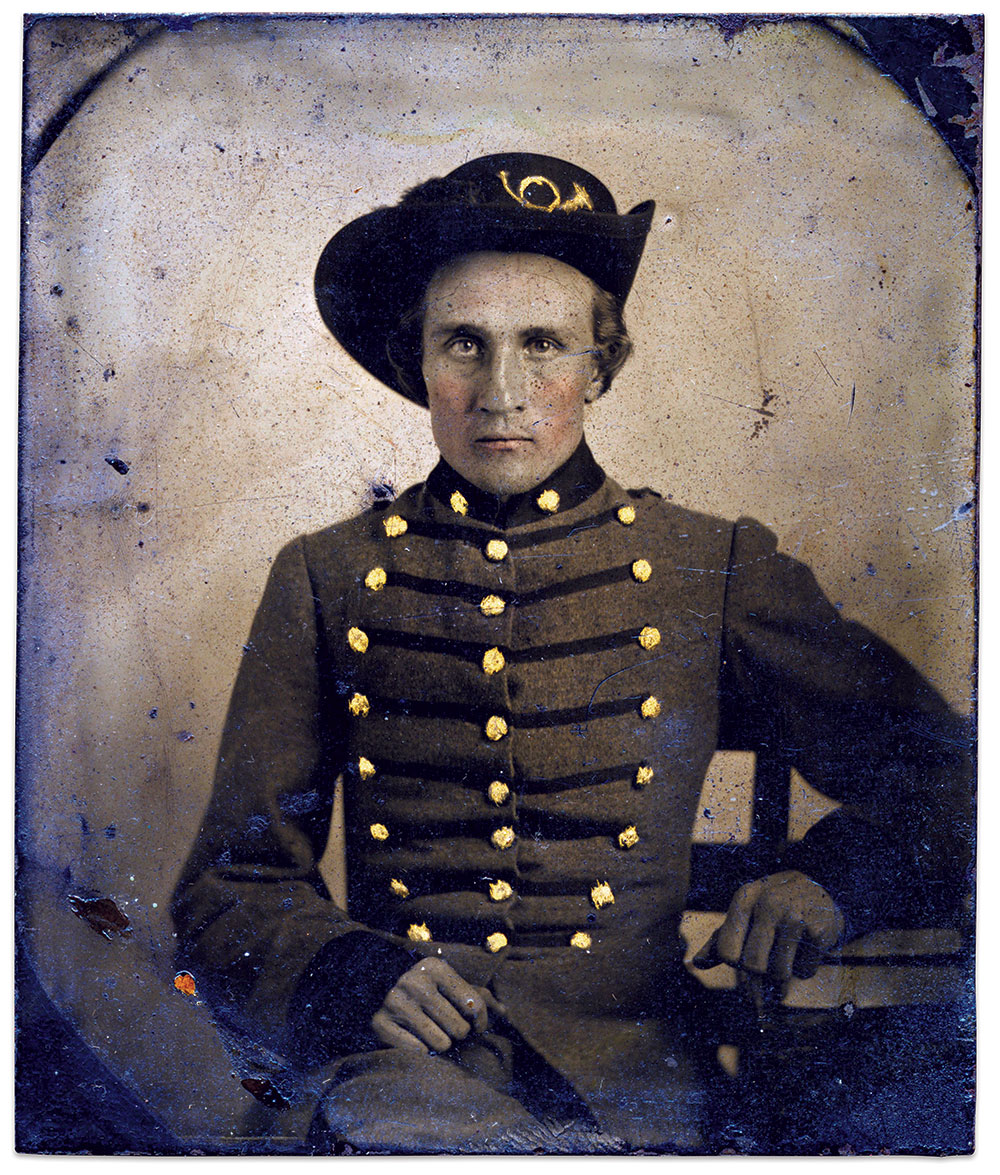
A member of the Lamar Rifles wears the uniform of the company when it mustered into Confederate service in early 1861. The uniform consisted of a gray frock coat with red trim on the collar and cuffs, and eight red chest bars with buttons at each end. Matching gray trousers with a red stripe down the side completed the look. He also wears the correct black Hardee hat with one side pinned up and a brass infantry bugle pin attached to the front.
Formed in Oxford, Miss., and named for Lucius Q.C. Lamar II, a member of the U.S. Congress who drafted Mississippi’s Ordinance of Secession, the Rifles became Company G of the 11th Mississippi Infantry. The regiment fought in 30 battles with the Army of Northern Virginia.
Surviving an amputation
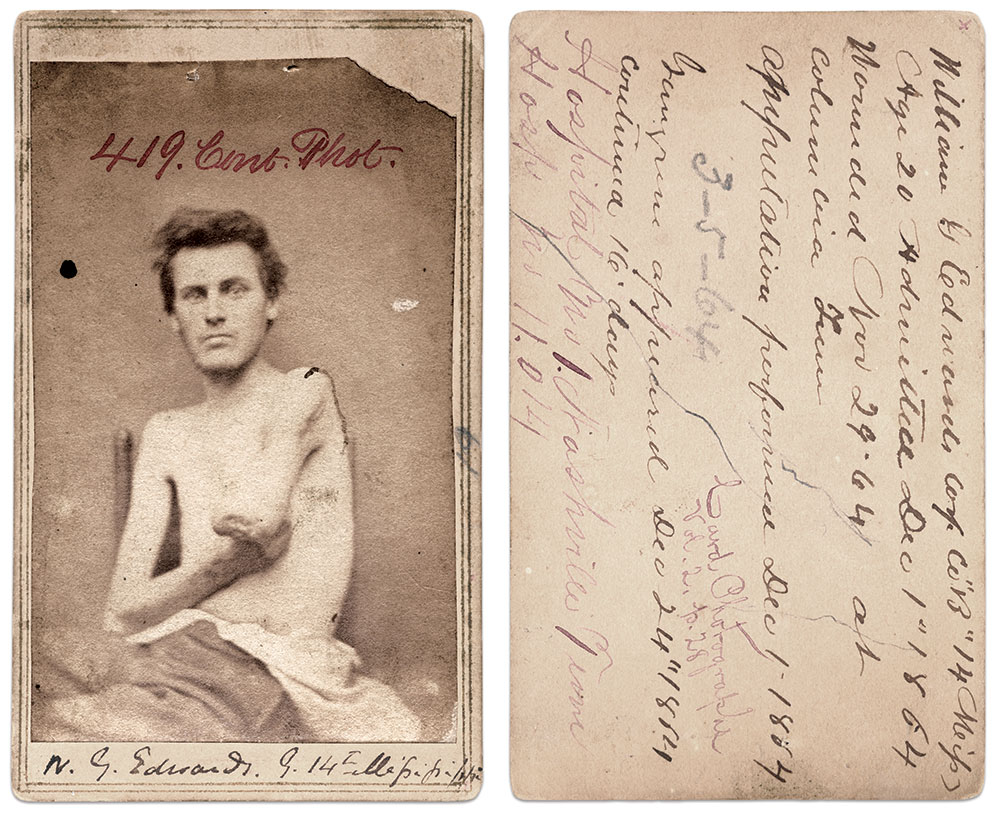
William G. Edwards of the 14th Mississippi Infantry displays the stump of his arm to document his surgery. An inscription on the back of the image mount and additional research reveals Union surgeons amputated the limb on Dec. 1, 1864, the day he gained admission to Hospital No. 1 in Nashville. He had suffered a gunshot to his left elbow two days earlier near Spring Hill, Tenn., in an action leading up to the Battle of Franklin the next day. Edwards fell into enemy hands at Franklin.
A resident of Enterprise, Miss., when the war began, Edwards joined the Enterprise Guards in 1861. It became Company B of the 14th. The following year at Fort Donelson, Tenn., federal forces captured Edwards and sent him to Camp Douglas in Chicago. Formally exchanged in September 1862, he returned to his regiment and advanced to corporal.
His post-amputation recovery was slowed by a 16-day bout with gangrene. He survived, and, following stints in the prison camps of Camp Chase, Ohio, and Point Lookout, Md., gained his release in June 1865.
Edwards returned to Enterprise and served for a time as town postmaster. He died in 1916 at the age 74 and was buried at Enterprise Cemetery.
Beard and star
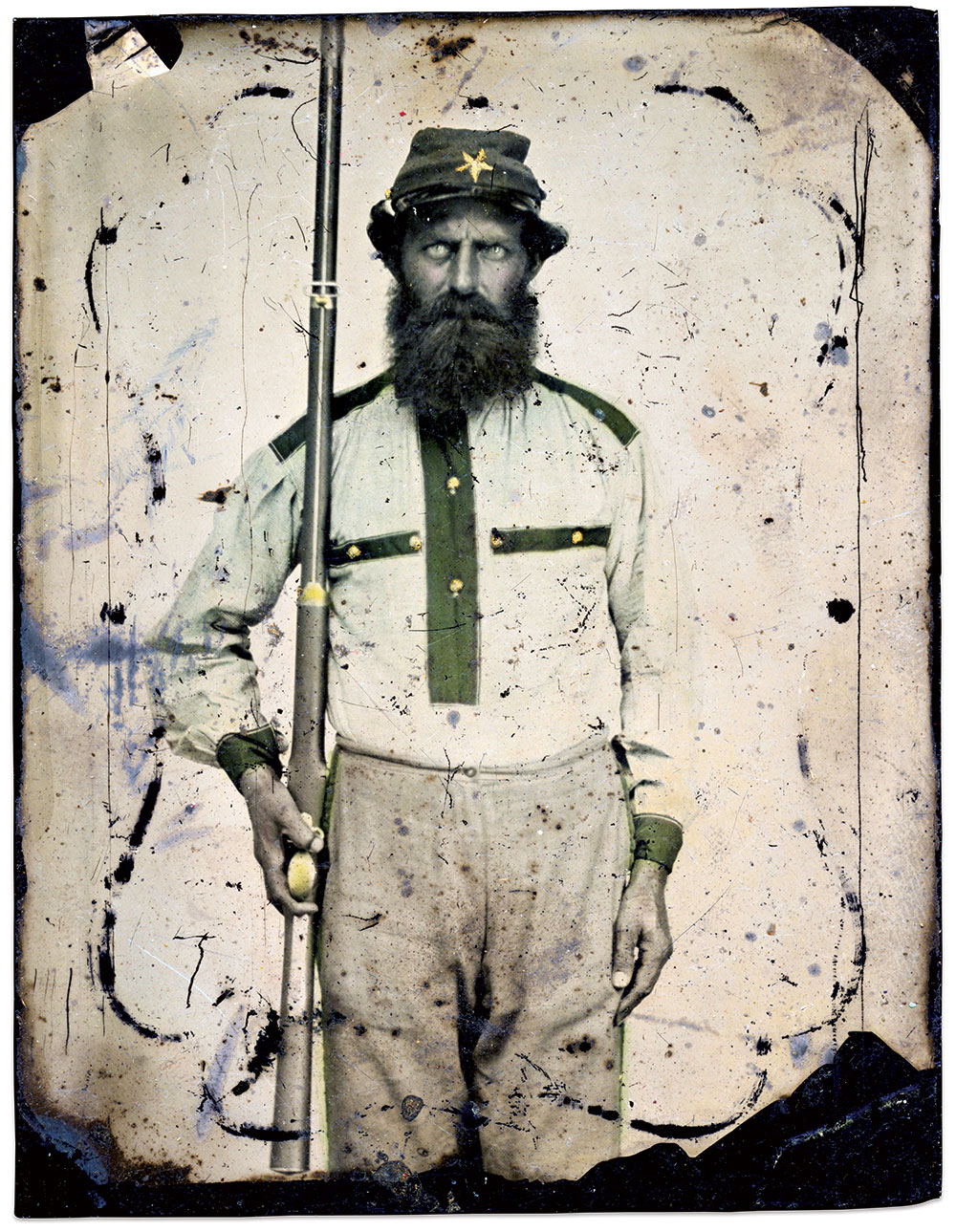
This portrait of a bushy bearded soldier with a star on his cap reportedly came out of an old Mississippi collection. Published in the July-August 1983 issue of MI and the Spring 1988 issue of Incidents of the War as Pvt. William Philip Gabriel of the 46th Mississippi Infantry, the identification has since been questioned and sold at least twice as an unidentified Confederate.
Twice a casualty
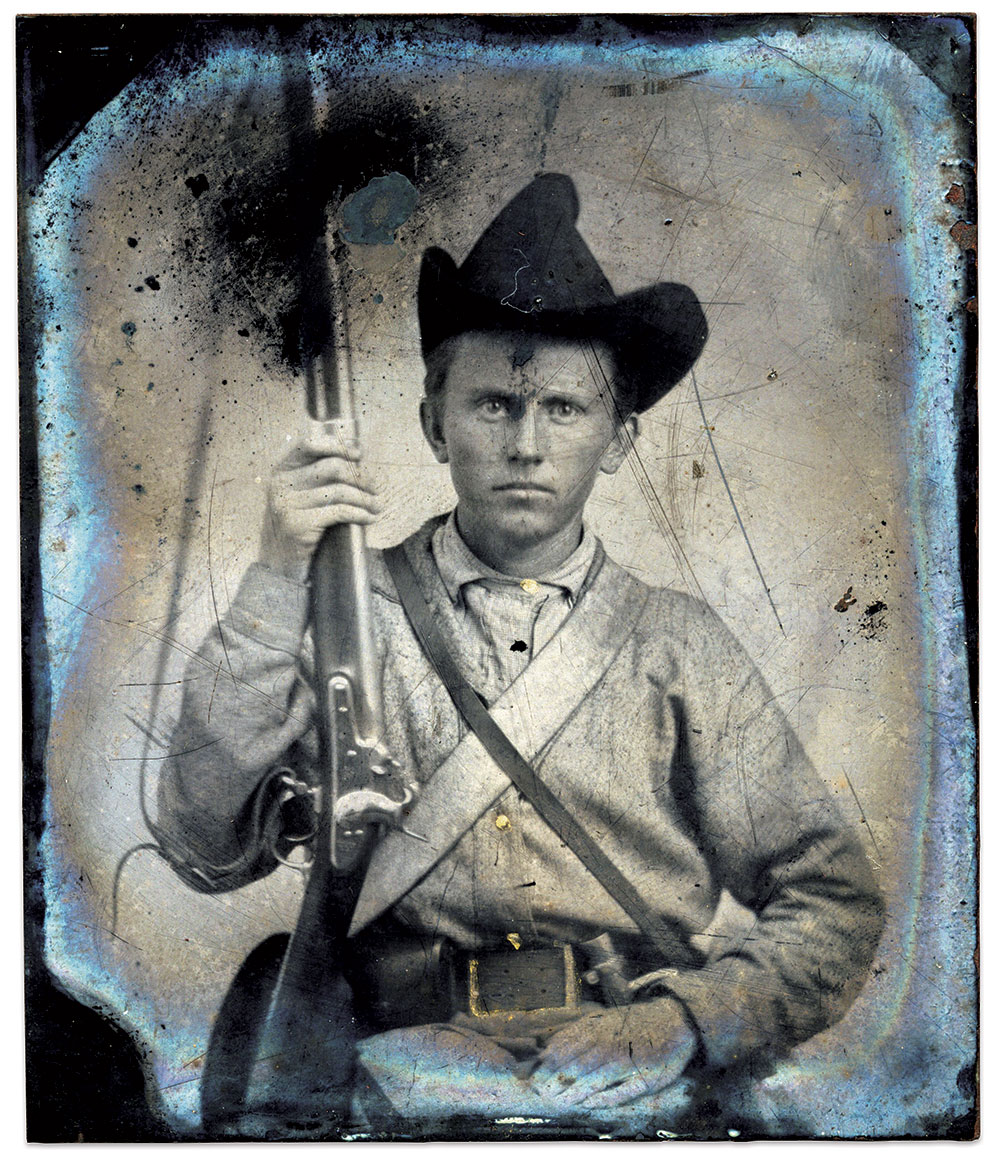
Henry Young Rowland, an 18-year-old farmer born in South Carolina, began his Confederate military service in March 1861 with the Winston Guards of Louisville, Miss. It eventually became a company in the 13th Mississippi Infantry. Pictured here early in his enlistment gripping a Model 1842 smoothbore musket, Rowland participated in numerous battles, including First Manassas, Savage’s Station, Malvern Hill, Antietam, Fredericksburg, Gettysburg, Chickamauga and the Siege of Knoxville.
He landed on the casualty list twice: at Fredericksburg in 1862 and the Battle of Fort Sanders outside Knoxville in 1863. At the latter, he fell into enemy hands and spent the rest of the war at Camp Chase, Ohio, and Rock Island, Ill. He gained his release in June 1865.
Rowland returned to Mississippi and farmed in Noxubee and Warren counties. Along the way he married and had two children. By 1910, Rowland moved to the state capital and worked as a night watchman at a factory. He died six years later at about age 74.
Confederate colors
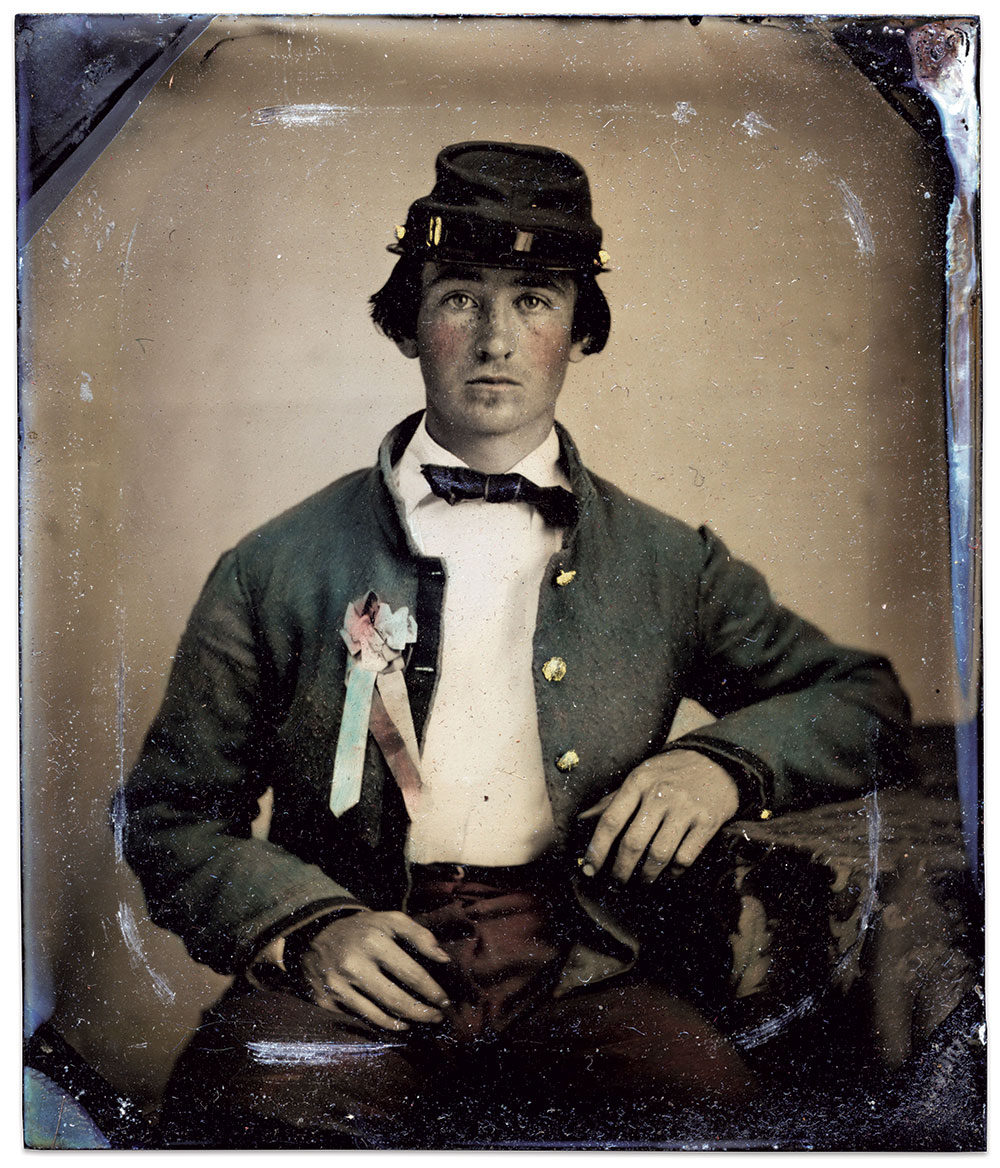
In 1861, the Adams Light Guard of Natchez mobilized for war as Company D of the 16th Mississippi Infantry. One of its members pictured here, Edward Livingston Hopkins, wears a secession cockade pinned to his shell jacket. The color tinting of his uniform, blue jacket and red trousers, and crisp white shirt and gray cap, are the colors of the Confederacy.
Hopkins, the son of English immigrants, was born in New York in 1834. In the early 1840s, his father, John, a carriage maker and artist, moved the family from New York City to Natchez. Hopkins grew up in the city and became a saddler. He may have worked for Livingston and Rountree, a prominent area harness and carriage company.
Hopkins started his war service as a second lieutenant and headed to the Eastern Theater with his regiment. After a year spent mainly training, the men voted for officers and Hopkins did not get elected. He promptly resigned, returned to Mississippi, and rejoined the army as a junior second lieutenant in Company F of the 31st Louisiana Infantry. Here he proved his abilities as an officer, rising in rank to full second lieutenant and participating in the Battle of Chickasaw Bluffs and other operations in the Vicksburg Campaign.
When the fortress city fell to U.S. forces on July 4, 1863, Hopkins was paroled and returned to duty in the Trans-Mississippi Department, where he fought in various conflicts in Louisiana, and advanced to first lieutenant.
After the end of hostilities, Hopkins returned to Natchez. Over the next four decades he worked as a saddler. In 1888, he established his own business, Messrs. Hopkins & Co, selling saddles, harnesses and carriages. He lived in Texas for a time, and had a marriage that ended with the death of his wife. Hopkins lived until in 1910. He was 75.
50 days at Port Hudson
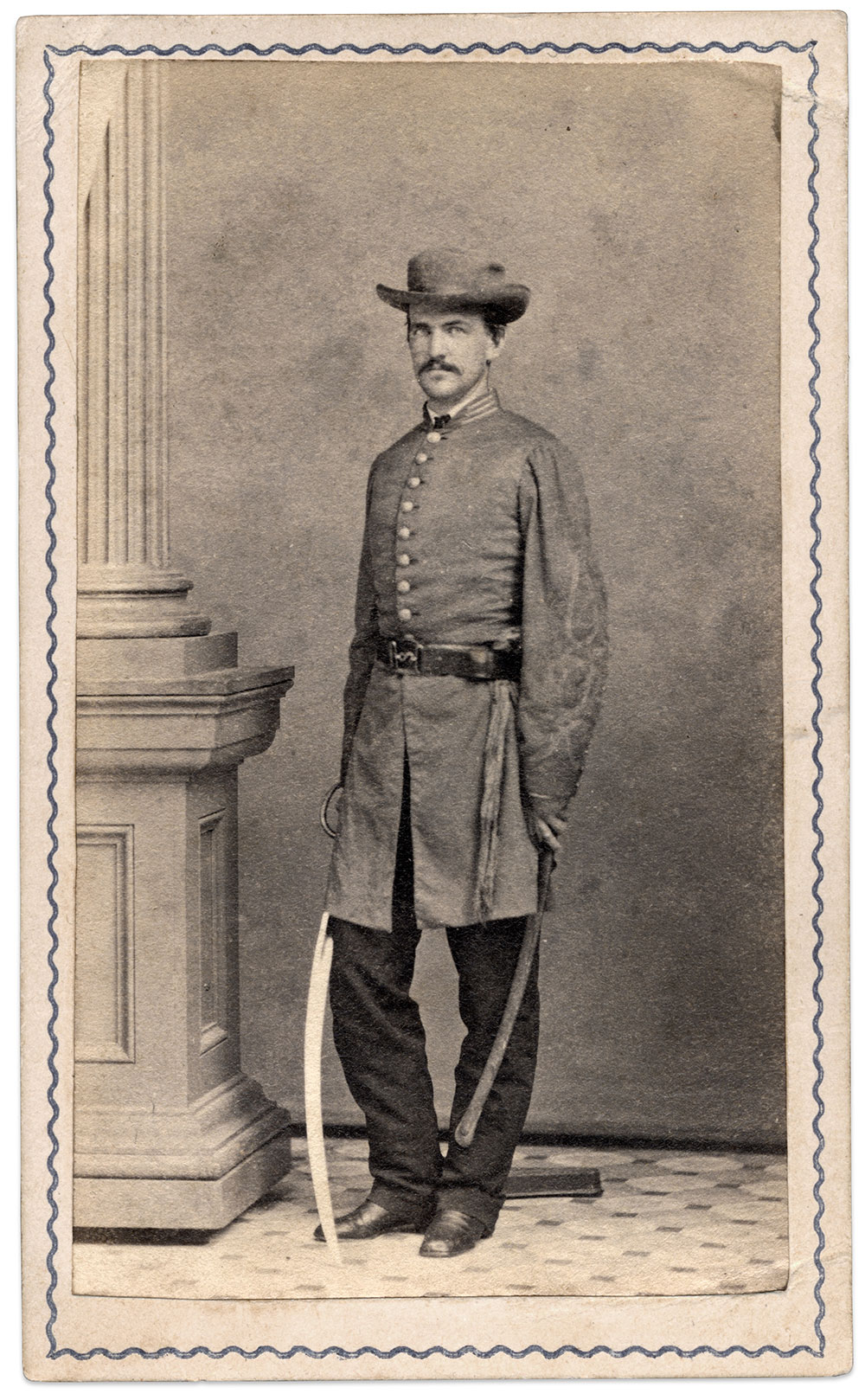
Abbay’s Battery boomed into action during the Battle of Plains Store, La., on May 21, 1863. The combat marked the beginning of a 50-day contest for the defense of nearby Port Hudson.
The battery, named for Capt. George Frederick Abbay, mustered into Confederate service about a year earlier as Battery K of the 1st Mississippi Light Artillery. Abbay, an 1860 Princeton graduate studying law in his hometown of Port Gibson, Miss., started the war as a first lieutenant in Capt. George V. Moody’s company of Louisiana Artillery, also known as the Madison Light Artillery. Abbay formed his own battery in May 1862.
Abbay and his artillerists manned the Defenses of Port Hudson as U.S. army and naval forces invaded the area and laid siege to the place. The battery performed well at Plains Store. Less than a week later, on May 27, the artillerymen helped repel an attack by Maj. Gen. Nathaniel P. Banks’ Union army. One Confederate officer recalled that federal troops approached within 200 yards of Abbay and his men. “The cannoneers switched from shell to double charges of canister. Captain George F. Abbay, wearing a badly crushed kepi and smoking a small, ‘squatty’ pipe, told his men, ‘Now boys, I want you to stick to the pieces and give the Yankees hell.’ Running their guns into position, they literally obeyed by blasting the Yankees with canister at the appropriate moment.”
Abbay’s Battery did its part to win the day. But it and other forces surrendered on July 9, 1863, after the fall of Vicksburg made Port Hudson untenable.
Abbay survived the siege, suffering a minor arm wound from a grape shot at some point. He spent the rest of 1863 and early 1864 as a prisoner of war at Johnson’s Island, Ohio. Exchanged in March 1864, he returned to active duty, only to be captured again on April 9, 1865, at the Battle of Fort Blakely, Ala.
After gaining his release, Abbay lived in Missouri, Arkansas and his native Mississippi. The last time his name appeared on a government document was the 1910 census. He was about 70 years old and a widower.
Grim humor at Vicksburg
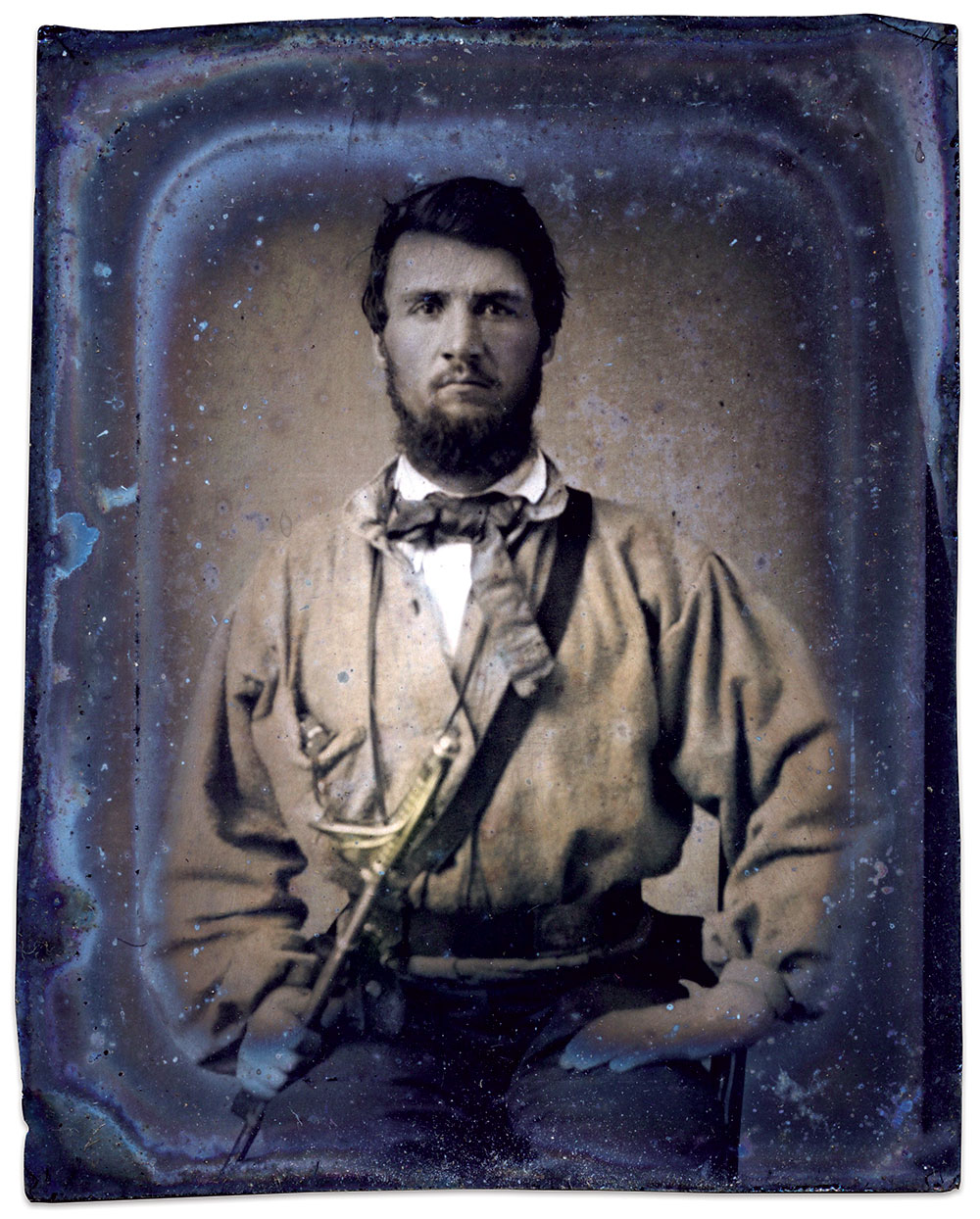
During the waning weeks of the Siege of Vicksburg, artilleryman Marion Berry Richmond recalled a humorous exchange with federals. He and his comrades in the 1st Mississippi Light Artillery were within audible range of the Yanks. “One night we asked them what they had to eat over there. The reply enumerated ‘beef, good bread, molasses, coffee,’ etc., and then asked what we had to eat. Some wag replied that we had ‘hot biscuit, young lamb, butter, coffee, cake,’ etc., when a Yank yelled back, ‘and pea meal.’” Both sides roared with laughter.
Richmond had enlisted in Company A of the 1st in April 1862 at Jackson, Miss. He posed for this portrait dressed in a button up blouse tinted yellow. A pouch protrudes from his breast pocket. He holds a sword that may be a Kenansville model. The belt rig, turned to show off the sword, features an extremely rare rectangular Mississippi eagle belt plate.
Richmond remained with the 1st until its surrender at Vicksburg on July 4, 1863. A few hours later, Union supply wagons rolled up with an enormous amount of food. Richmond and his hungry comrades ate until they were stuffed, slept until they digested the meal, and then repeated the cycle. Three days later, they signed the Oath of Allegiance to the federal government. He received his parole two months later and returned to his regiment, where he remained until May 1865.
Richmond lived until 1930, dying at age 86 in Los Angeles, Calif. He outlived his wife, Leonora, and was survived by two children.
This image was published in the 1995 book Still More Confederate Faces by Domenick A. Serrano.
Yellow plume and crossed arms
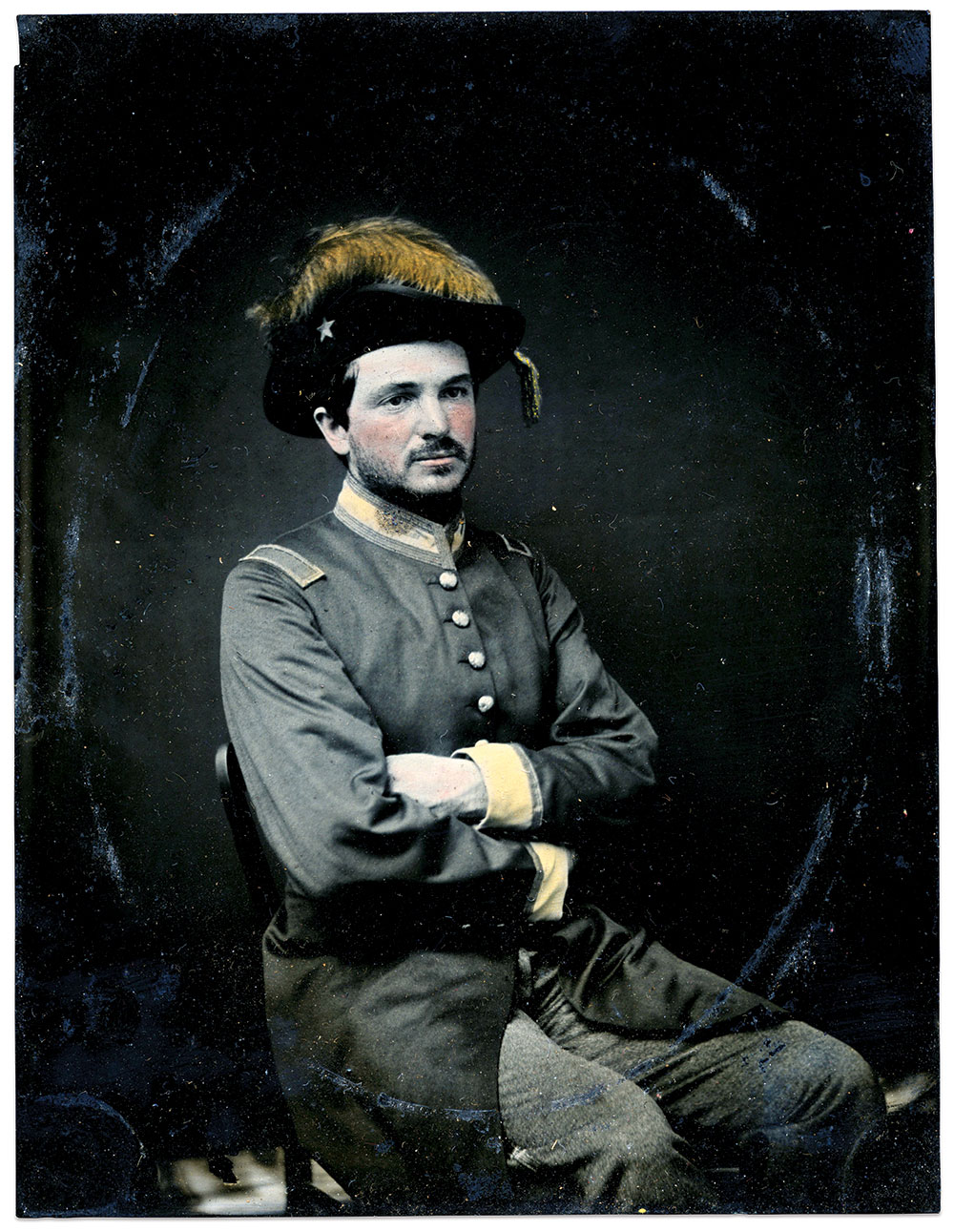
This cavalry trooper is uniformed in a frock coat with collar, cuffs and shoulder straps tinted yellow consistent with his branch of the service. The single bar on his collar distinguishes him as a second lieutenant, though it may have been a decorative element worn by all members of his unit. He wears a dark hat topped by a yellow plume and star pinned to the folded brim.
This portrait was reportedly purchased from a family in Vaiden, Carroll County, Miss., with the surname Anderson. One soldier from Vaiden had this name: Gaius Milton “Gay” Anderson (1836-1896), who served in Company E of the 1st Battalion Mississippi Cavalry (Miller’s). This unit became Company A of the 1st Mississippi Cavalry in June 1862. Anderson was a private early in the war and advanced to second lieutenant in June 1864.
The owner of Rose Cottage
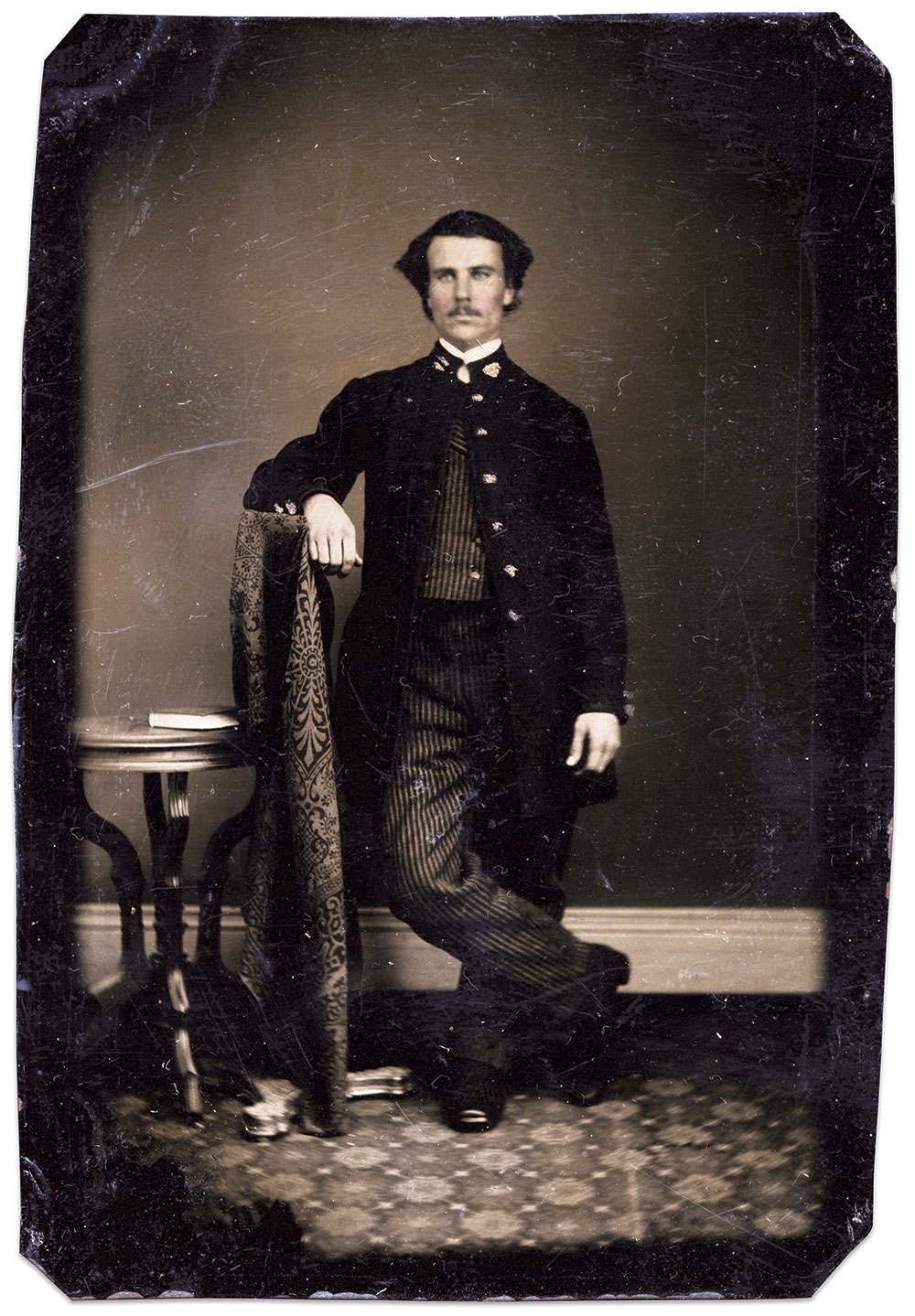
Rose Cottage, its name suggested by its exterior color, is forever connected to Gen. Albert Sidney Johnston. Located in Corinth, Miss., the home served as headquarters to the general and his staff prior to Shiloh, and, after his mortal wounding and death in the battle, the place where his remains lay in state.
The owner of Rose Cottage is pictured here. He is William Murphy Inge, an Alabama native who had moved to Corinth as a child. In 1848, at age 16, he gained admission to West Point, but did not graduate. In the early 1850s, he married Florida Augusta Evans, started a family that grew to include three children who lived to maturity, and supported them as an attorney.
During the war’s first year, Inge served as a captain in the 9th and 12th Mississippi infantries and a stint on the staff of Brig. Gen. Richard Griffith.
At Shiloh in April 1862, Inge served as a volunteer aide to Brig. Gen. Charles Clark. One wartime account by a Johnston staffer mentions Inge on the day the general died. A postwar reminiscence asserts that Inge accompanied Johnston’s body from the battlefield to Rose Cottage. This account also mentions that Inge’s wife and another woman wrapped Johnston’s remains in a Confederate flag before they were sent off for burial.
After Shiloh, Inge joined the staff of Brig. Gen. William Barksdale, serving as captain and assistant adjutant general. In March 1863, he left to become the major of the 12th Mississippi Partisan Rangers. A cavalry battalion of about 250 effectives, it participated in skirmishes in Mississippi and Georgia, notably the Atlanta and Savannah campaigns.
In January 1865, the Rangers merged into the 10th Mississippi Cavalry, and Inge advanced to colonel of the regiment. He poses here about the time he took command, dressed in a dark uniform with collar insignia. Inge led his Mississippians during the Carolinas Campaign and surrendered with the rest of his troopers at Durham Station, N.C., on April 26, 1865.
After his release, Inge returned to Rose Cottage and resumed his career as an attorney. He entered politics, serving as a state representative and, from 1884-1886, as speaker of the Mississippi’s House of Representatives.
Inge died in 1900 at age 68, and Flora in 1925. Rose Cottage burned to the ground in 1920.
Saxhorns in gray

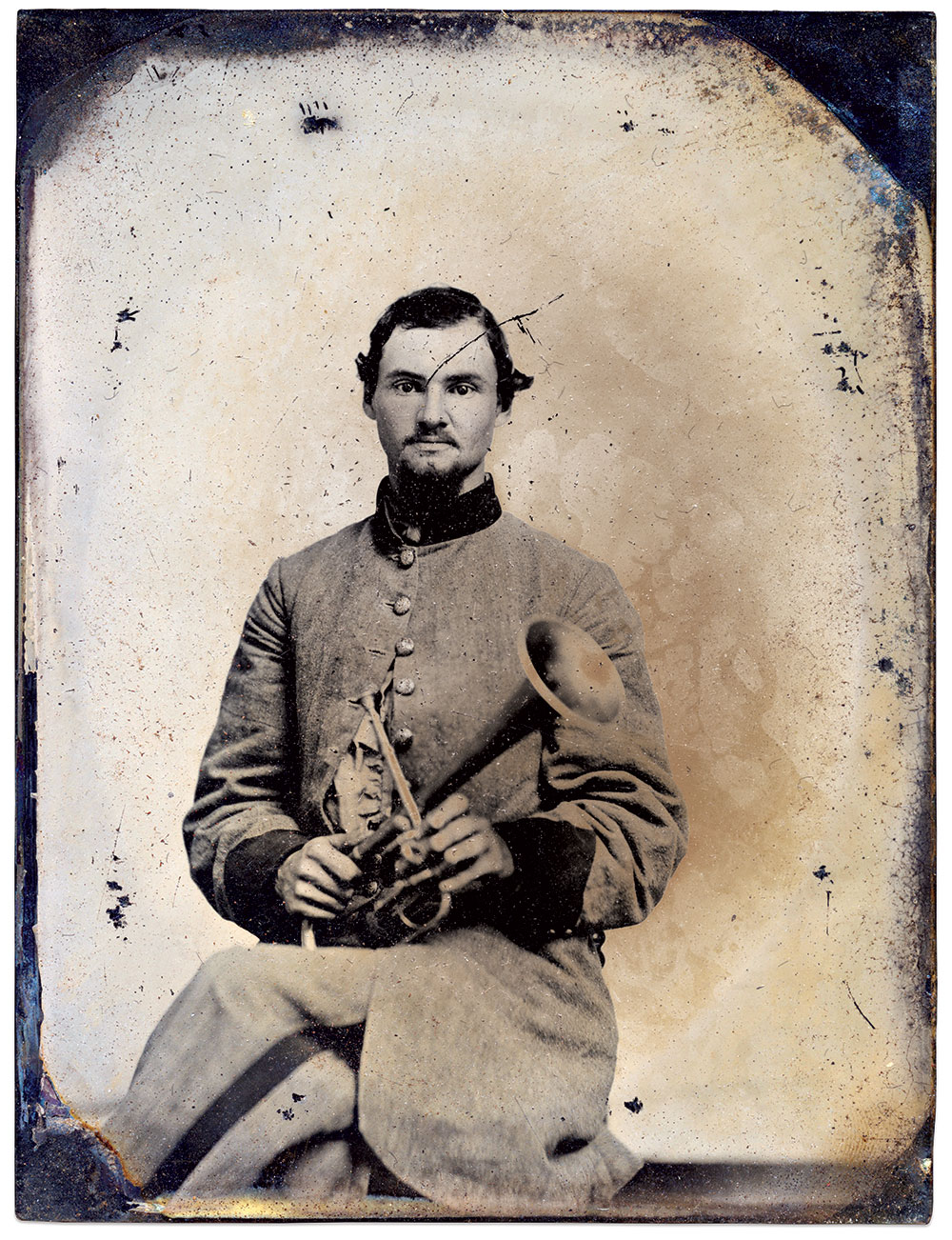
In December 1862, Gen. Braxton Bragg detailed Charles Garrett Stone to procure brass instruments in Atlanta for regimental bandsmen in the Army of Tennessee. The upright soprano saxhorns that he and his older brother, Joseph Newman Stone, hold in these portraits may be the successful result of the trip.
Born in Woodville, Miss., to a physician-father who hailed from New Jersey and an English mother, Joseph and Charles joined a militia unit in Natchez, Miss., two days after Fort Sumter. It became Company G of the 1st Confederate States Infantry. A year later, they enlisted in Buck’s Company, Mississippi Cavalry, named for its commander, Capt. James H. Buck.
Military service records indicate Charles’ talents as a musician were much in demand. He served several stints on detached service with the 32nd Alabama Infantry as chief musician, and in the 6th and 9th Tennessee infantries, and transferred to the 1st Louisiana Cavalry in early 1864. Joseph appears to have remained with his company, suffering a gunshot wound in late 1863 — possibly during operations connected with the Chickamauga Campaign. He and the rest of Buck’s Company ended their service as escort to Maj. Gen. William B. Bate and were surrendered in North Carolina by Gen. Joseph E. Johnston in April 1865.
The brothers returned to Mississippi and died at relatively young ages. Charles passed away in 1872 at about age 31. He was single. Joseph lived until 1886, dying at age 47. His wife and several children survived him.
These images were published in North South Trader’s Civil War in 2008.
SPREAD THE WORD: We encourage you to share this story on social media and elsewhere to educate and raise awareness. If you wish to use any image on this page for another purpose, please request permission.
LEARN MORE about Military Images, America’s only magazine dedicated to showcasing, interpreting and preserving Civil War portrait photography.
VISIT OUR STORE to subscribe, renew a subscription, and more.


1 thought on “Mississippi Faces: Portraits from the Matthew L. Oswalt M.D. Collection”
Comments are closed.